Chicago
French Jesuits built the Mission of the Guardian Angel in 1696 near the mouth of the Chicago River to convert the local Indians to Christianity. The name Chicago is derived from the Indian word ‘shikaakwa’ (stinky onion) after plants that grew along the river. Indian raids resulted in the mission being abandoned after a few years. Neither the French nor the British made any other attempt to settle near the mouth of the Chicago River. In 1803 the US started building Fort Dearborn and fur traders soon established a town alongside it. The fort was destroyed by the British during the war of 1812 but rebuilt in 1818. In 1829 the town of Chicago was laid out and from the 1830s it grew fast as it became an increasingly important transportation hub. Fire destroyed most of Chicago in 1871, but the city arose from the ashes, this time built predominantly from brick and stone rather than timber.
Downtown & Lake Michigan from Willis (Sears) Tower at sunset
You can find the statistics for the Willis Tower (formerly the Sears Tower) on the Illinois page, where we also recommended seeing the sunset from the Sky Deck on the 103rd floor. Well, here is the evidence - a view taken at 6.25 pm in late September looking east over the City and Lake Michigan. The low sun is bathing the skyscrapers in a warm pink glow. Click Tab 2 to see a view to the west taken the same day at 6:45 pm. The sun has just sunk below the horizon painting an intense red colour on high clouds to the west of the City. The street lights and car lights are beginning to glow in the twilight revealing the grid pattern of the roads.
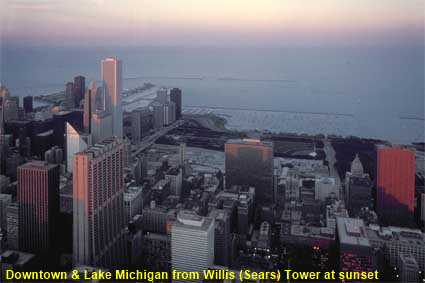
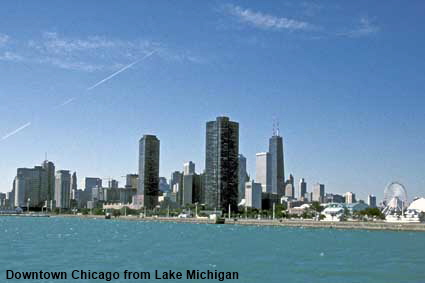
Click on Minimap to navigate
Statue of Lincoln, Lincoln Park
The link between Abraham Lincoln and Illinois is reflected in a special statue in its largest city. In Lincoln Park east of the Chicago History Museum is a statue called ‘Abraham Lincoln: The Man’ known affectionately to Chicagoans as Standing Lincoln. Chicago lumber merchant Eli Bates died in 1881 and in his will he left $40,000 for a monument to Lincoln in Lincoln Park. Irish immigrant Augustus Saint-Gaudens was selected to create the monument. Saint-Gaudens had seen Lincoln at his inauguration and had seen his body lying in state. He found a farmer from Vermont with a similar build to Lincoln to use as a mode. He also had access plaster a life mask of Lincoln and casts of his hands that sculptor Leonard W. Volk had made in 1860. The statue was unveiled by Lincoln’s grandson (also Abraham Lincoln) on October 22, 1887.
Downtown Chicago from Lake Michigan
The origin of Chicago’s nickname of the ‘Windy City’ is not clear. Like other cities located on a waterfront, it can suffer from high winds, but it is far from being the windiest place in the USA. One theory is that it does not refer to meteorological wind but instead is based on a perception that Chicagoans once had a tendency indulge in unjustified bragging. Chicago can definitely lay claim to being the ‘Birthplace of the Skyscraper’. After the 1871 fire new buildings sprang up. They were typically only 5 stories high but compared to the buildings that had been destroyed the new buildings seemed incredibly tall. By the 1880s Chicago had steel framed buildings that were 10 stories high, and the word skyscraper was used to describe them. The early skyscrapers may now seem low rise but are worth seeing as many of them have interesting shapes and their exteriors are beautifully decorated. The picture shows that downtown Chicago is now dominated by modern skyscrapers such as the Willis (or Sears) Tower, but there are still many early skyscrapers to be found. What else does Chicago bring to mind? During the late 19th and early 20th century massive immigration fuelled rapid growth. The law enforcement and justice systems failed to cope resulting in a spiralling murder rate. During Prohibition in the 1920s, the proximity of Chicago to Canada made it an ideal bootlegging centre for gangsters such as Al Capone. Those days have long gone and there is no need for either a bullet proof vest or a violin case when visiting Chicago.
DLU130528


To move forwards or backwards through the Illinois trail click the arrows above.
We have other pages on Chicago. Click below or on the Minimap:
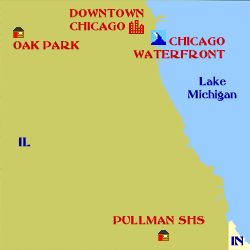

Click on Minimap to navigate
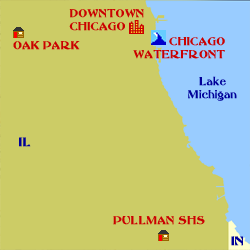
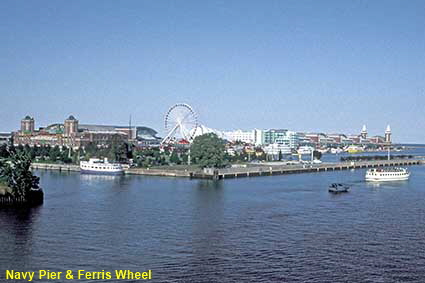
Navy Pier Ferris Wheel, Chicago, IL, USA
By the early 20th century, the port was outgrowing the facilities on the Chicago River so a plan was put forward to construct piers on the Lake Michigan waterfront. Navy Pier was built between 1914 and 1916 and originally called simply Municipal Pier. From the 1930s the port relocated to the new deep water Port of Chicago leaving Navy Pier primarily as a recreational facility apart from being used for military purposes during World War II. Now boasting a fun fair, exhibition hall, numerous shops and restaurants and even a Shakespearean theatre, the pier remains a major tourist attraction. Click Tab 2 to see a picture taken in the Shopping Mall on Navy Pier.
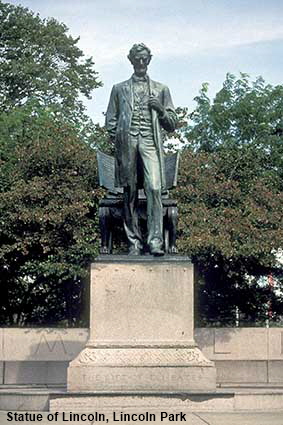
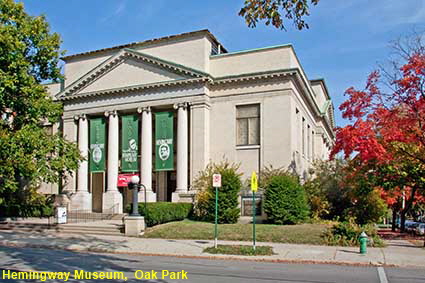
Hemingway Museum, Oak Park
Ernest Hemingway may be most associated with Key West and Cuba, but he was born in the Oak Park suburb of Chicago. You can see the house in which he was born in the Oak Park page, but a short distance away the Oak Park Arts Centre has a Hemingway Museum. The museum covers his life from childhood to his death. Inside kiosks built from historic doors are exhibits of rare photographs and Hemingway artefacts, including his childhood diary and the famous letter from nurse Agnes von Kurowsky terminating their engagement that he later portrayed in ‘A Farewell to Arms’.
© Mike Elsden 1981 - 2025
The contents of this page may not be reproduced in full or in part without permission